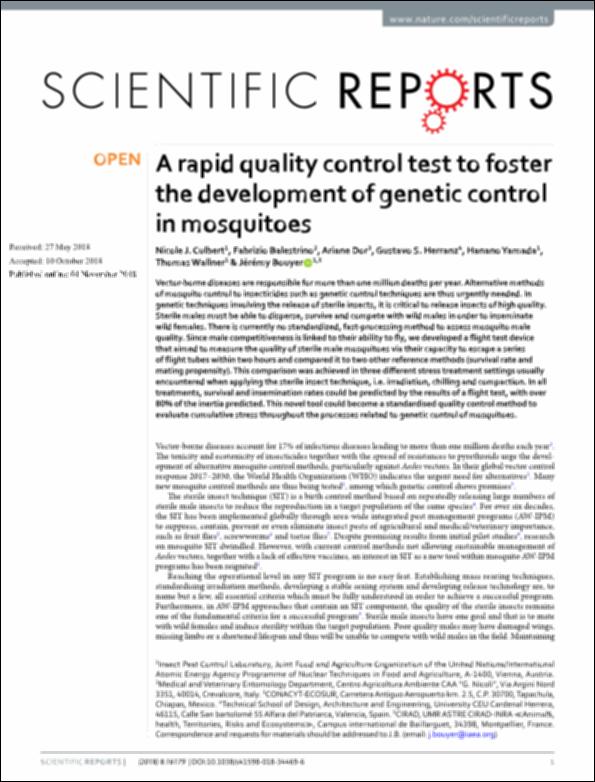Please use this identifier to cite or link to this item:
http://hdl.handle.net/10637/10248A rapid quality control test to foster the development of genetic control in mosquitoes.

See/Open:
Rapid_Culbert_SR_2018.pdf
1,28 MB
Adobe PDF
See/Open:
Rapid_Culbert_SR_2019.pdf
665,58 kB
Adobe PDF
| Title: | A rapid quality control test to foster the development of genetic control in mosquitoes. |
| Authors : | Culbert, Nicole J. Balestrino, Fabrizio Dor, Ariane Salvador Herranz, Gustavo Yamada, Hanano Wallner, Thomas Bouyer, Jérémy |
| Keywords: | Genética de poblaciones - Modelos matemáticos.; Population genetics - Mathematical models.; Culícidos - Genética - Control.; Mosquitoes - Genetics - Control. |
| Publisher: | Springer Nature. |
| Citation: | Culbert, NJ., Balestrino, F., Dor, A., Herranz, GS., Yamada, H., Wallner, T. et al. (2018). A rapid quality control test to foster the development of genetic control in mosquitoes. Scientific Reports, vol. 8 (november), art. 16179. DOI: https://doi.org/10.1038/s41598-018-34469-6 |
| Abstract: | Vector-borne diseases are responsible for more than one million deaths per year. Alternative methods of mosquito control to insecticides such as genetic control techniques are thus urgently needed. In genetic techniques involving the release of sterile insects, it is critical to release insects of high quality. Sterile males must be able to disperse, survive and compete with wild males in order to inseminate wild females. There is currently no standardized, fast-processing method to assess mosquito male quality. Since male competitiveness is linked to their ability to fly, we developed a flight test device that aimed to measure the quality of sterile male mosquitoes via their capacity to escape a series of flight tubes within two hours and compared it to two other reference methods (survival rate and mating propensity). This comparison was achieved in three different stress treatment settings usually encountered when applying the sterile insect technique, i.e. irradiation, chilling and compaction. In all treatments, survival and insemination rates could be predicted by the results of a flight test, with over 80% of the inertia predicted. This novel tool could become a standardised quality control method to evaluate cumulative stress throughout the processes related to genetic control of mosquitoes. |
| Description: | Este artículo se encuentra disponible en la página web de la revista en la siguiente URL: https://www.nature.com/articles/s41598-018-34469-6 |
| URI: | http://hdl.handle.net/10637/10248 |
| Rights : | http://creativecommons.org/licenses/by/4.0/deed.es |
| ISSN: | 2045-2322. |
| Issue Date: | 1-Nov-2018 |
| Center : | Universidad Cardenal Herrera-CEU |
| Appears in Collections: | Dpto. Proyectos, Teoría y Técnica del Diseño y la Arquitectura |
Items in DSpace are protected by copyright, with all rights reserved, unless otherwise indicated.

